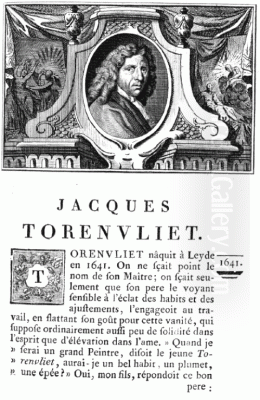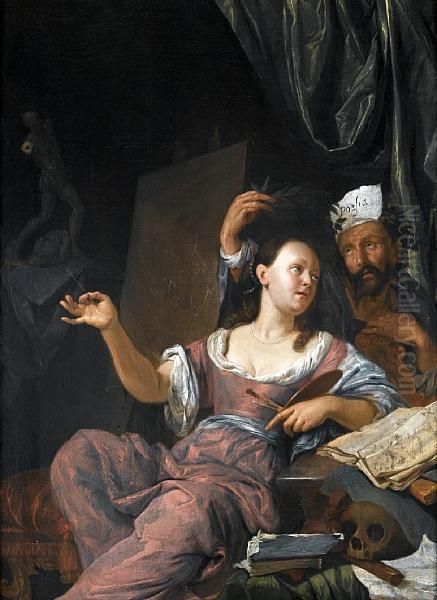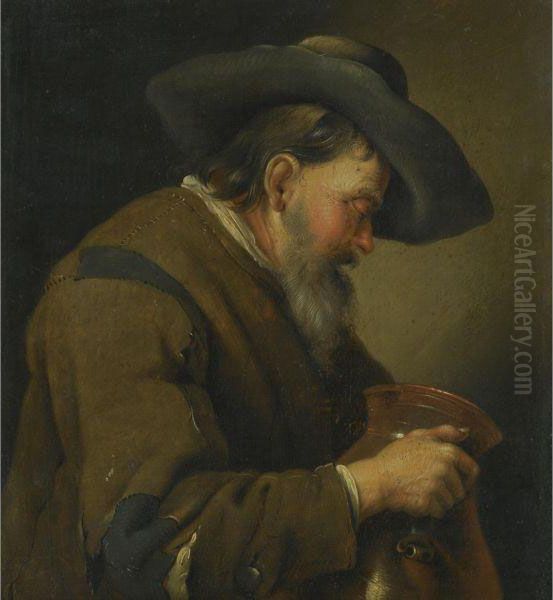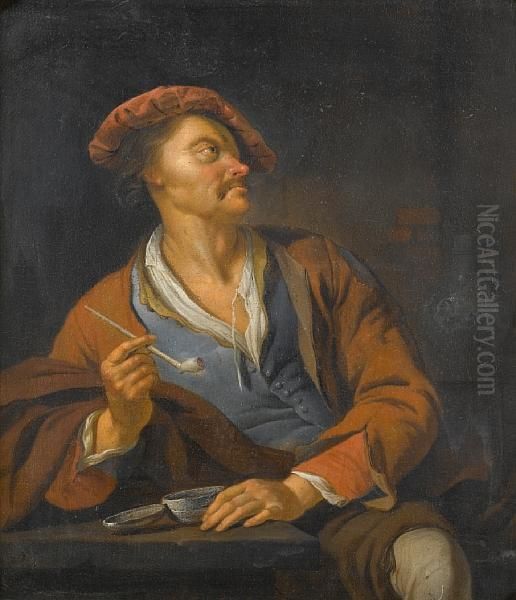An Introduction to a Leiden Luminary

The Dutch Golden Age, spanning roughly the 17th century, stands as one of the most remarkable periods in the history of Western art. Fueled by newfound national independence, economic prosperity through global trade, and a burgeoning middle class eager to decorate their homes, the Dutch Republic witnessed an explosion of artistic production. While giants like Rembrandt van Rijn and Johannes Vermeer often dominate the narrative, the era's richness lies equally in the vast number of highly skilled specialists who catered to diverse tastes. Among these was Jacob Toorenvliet, a prominent figure in the Leiden school of fijnschilders, or "fine painters," whose meticulously crafted works offer intimate glimpses into the life, preoccupations, and aesthetic values of his time.
Born and primarily active in the university city of Leiden, Toorenvliet carved a niche for himself with his exquisitely detailed genre scenes, portraits, and allegorical compositions. His art embodies the precision, technical brilliance, and focus on domesticity characteristic of the Leiden school, yet it also reveals a breadth of interest encompassing travel, intellectual pursuits, and even the arcane world of alchemy. Though perhaps not achieving the stratospheric fame of some contemporaries during his lifetime, Toorenvliet was a respected master, an influential teacher, and a key figure in Leiden's artistic institutions, leaving behind a legacy that continues to be appreciated for its refinement and quiet charm.
Early Life and Artistic Formation in Leiden
Jacob Toorenvliet entered the world in Leiden on July 1, 1640. His artistic inclinations were likely nurtured from a very young age. His father, Abraham Toorenvliet, was not only a respected glass painter but also a drawing master, providing Jacob with his initial instruction in the fundamentals of art. His mother was Maria Willemsdr van der Hulle. The family environment was steeped in craft and artistry, further solidified when, after his mother's passing, his father married Susanna Verhulst, the daughter of a glass manufacturer. This early immersion in a world where technical skill and aesthetic judgment were paramount undoubtedly shaped the young artist's path.

Leiden itself was a stimulating environment. Home to a prestigious university founded in 1575, it was a center of learning, science, and intellectual debate. This atmosphere likely influenced Toorenvliet's later interest in subjects like medicine and alchemy. However, the most decisive influence on his artistic development came from his formal training. He became a pupil of Gerrit Dou, arguably the most famous Leiden painter of his generation and Rembrandt's first pupil. Dou was the founding father of the Leiden fijnschilder tradition, renowned for his incredibly detailed, small-scale paintings with smooth, enamel-like surfaces.
Under Dou's tutelage, Toorenvliet would have absorbed the meticulous techniques and aesthetic principles that defined the fijnschilder style. This involved painstaking attention to detail, the subtle rendering of light and shadow (chiaroscuro), and an extraordinary ability to depict different textures – silk, velvet, metal, wood – with convincing realism. Further refining his skills, Toorenvliet is also documented as having studied with Frans van Mieris the Elder, another star pupil of Dou and a master fijnschilder in his own right, celebrated for his elegant high-life genre scenes. This combination of influences provided Toorenvliet with an exceptional technical foundation.
The Leiden Fijnschilder Tradition
To fully appreciate Jacob Toorenvliet's work, it is essential to understand the context of the Leiden fijnschilder school. This distinct movement, largely initiated by Gerrit Dou, dominated Leiden's artistic output for much of the 17th century. The fijnschilders specialized in small, highly finished panel paintings, primarily intended for close viewing in domestic interiors. Their hallmark was an almost microscopic level of detail and a polished, smooth surface where individual brushstrokes were often invisible, creating an illusionistic effect that captivated contemporary collectors.
The subject matter typically revolved around intimate genre scenes: kitchens, studies, shops, doctor's visits, musicians, and quiet moments of domestic life. Portraits, often small-scale and equally detailed, were also common. Light played a crucial role, often employed dramatically using chiaroscuro techniques inherited from Rembrandt via Dou, highlighting specific details and creating a sense of intimacy or sometimes mystery. The meticulous rendering of textures was paramount, showcasing the artist's virtuosity and appealing to the tactile sensibilities of the viewer.
Key figures associated with this tradition, besides Dou and Frans van Mieris the Elder, include Pieter Cornelisz van Slingelandt, known for his almost unbelievably painstaking detail; Godfried Schalcken, famous for his candlelit scenes; and Domenicus van Tol, Dou's nephew and follower. Toorenvliet operated firmly within this milieu, adopting its core tenets of precision, refined finish, and focus on intimate subjects. His works exemplify the Leiden school's dedication to craftsmanship and illusionistic detail.
Travels and Broadening Horizons: Vienna and the Roman Question

While deeply rooted in Leiden, Toorenvliet's career was not confined solely to his hometown. Like many artists of the period seeking broader experience and patronage, he traveled. Records indicate his presence in Vienna, a major European capital, suggesting a period spent working or studying there, likely absorbing different artistic currents. This exposure to an international center would have broadened his perspective beyond the specific confines of the Leiden school.
More debated is the assertion, primarily stemming from the influential artist biographer Arnold Houbraken, that Toorenvliet spent a significant period, perhaps between 1667 and 1679, studying in Rome and Venice. Italy, particularly Rome, was the ultimate destination for ambitious Northern European artists, offering the chance to study classical antiquity and the masterpieces of the Italian Renaissance and Baroque firsthand. Masters like Raphael and Tintoretto were revered, and exposure to their work was considered essential for a complete artistic education.
However, documentary evidence casts some doubt on an extended Italian sojourn during these specific years. Records place Toorenvliet back in Leiden for periods within this timeframe, including his marriage and documented artistic activity like the creation of a version of Doctor's Visit dated 1676. It's possible Houbraken conflated dates or that Toorenvliet made shorter trips. Alternatively, some scholars suggest he may never have gone to Italy at all, absorbing Italianate influences through prints or the work of other Dutch artists who had made the journey (the "Italianates"). Regardless of the specifics, some of his works do show an engagement with historical or religious themes that might suggest exposure to Italian art, whether direct or indirect.
Return to Leiden: Guild, Academy, and Mature Career
Around 1679, Jacob Toorenvliet settled definitively back in Leiden, becoming a pillar of the city's artistic community. He had married Sophia Dircx van Driel in 1678, and although details about a possible earlier marriage remain obscure, his family life took root in Leiden. An interesting footnote from this period is the secret Catholic baptism of his son, Abraham, in 1682. In the predominantly Protestant Dutch Republic, this suggests Toorenvliet himself may have harbored Catholic sympathies or even converted, a personal aspect potentially reflected in some of his later religious or allegorical works.
His standing among his peers was confirmed by his active role in the Guild of St. Luke, the professional organization for painters and other craftsmen. He served as its secretary in 1686 and later held the prestigious position of Dean (Hoofdman), indicating the respect he commanded within the Leiden art world. His commitment to upholding artistic standards and fostering the next generation of artists culminated in a significant institutional contribution.

Around 1694, Toorenvliet, alongside fellow Leiden masters Willem van Mieris (the son of his former teacher Frans the Elder) and Carel de Moor, co-founded the Leiden Drawing Academy (Leidse Tekenacademie). This was a crucial initiative aimed at providing structured training, particularly in drawing from live models, which was considered the foundation of all art. In an era where the Guild system was gradually evolving, such academies helped maintain professional standards and offered aspiring artists formal instruction beyond the traditional workshop apprenticeship. Toorenvliet's involvement underscores his dedication to art education and his leadership role in Leiden.
Artistic Style and Techniques: The Refined Hand
Jacob Toorenvliet's style is the epitome of the Leiden fijnschilder aesthetic, characterized by meticulous execution and a refined sensibility. His brushwork is typically smooth and controlled, often leaving little trace of individual strokes, contributing to the polished, almost enamel-like surface quality highly prized by collectors of Leiden paintings. This technique allowed for an extraordinary level of detail, rendering the textures of fabrics, the gleam of metal, the grain of wood, and the translucency of glass with remarkable fidelity.
He possessed a masterful command of light and shadow. Often employing a subtle chiaroscuro, he used light not just to illuminate his scenes but also to create mood, focus attention, and enhance the sense of three-dimensionality. Interior scenes are frequently bathed in a warm, gentle light, often emanating from a window just outside the picture frame, a common device used by Dou and his followers. This careful manipulation of light contributes significantly to the intimacy and quiet atmosphere of many of his works.
While adhering to the core principles of the Leiden school, Toorenvliet's handling could sometimes be slightly broader or more fluid than that of the most extreme practitioners like Slingelandt, allowing for a degree of expressiveness within the highly detailed framework. His compositions are carefully constructed, often featuring figures engaged in quiet activities within well-defined interior spaces, creating balanced and harmonious scenes that invite close inspection.
Themes and Subject Matter: Windows into Dutch Life
Toorenvliet explored a range of subjects popular in the Dutch Golden Age, reflecting the tastes and interests of his clientele. Genre scenes form a significant part of his oeuvre. These include the intimate domestic interiors typical of the Leiden school, depicting activities like reading, music-making, or tending to household chores. He also painted scenes featuring scholars in their studies, reflecting Leiden's academic character, and physicians attending patients, a theme particularly popular among Leiden artists.
His depictions of peasant life or lower-class interiors, sometimes infused with gentle humor, connect him to artists like Adriaen van Ostade or Jan Steen (another Leiden native, though stylistically different). These works often carry subtle moralizing undertones, a common feature in Dutch genre painting, encouraging viewers to reflect on virtue and vice.
Allegory also features in his work, most notably in paintings like Allegory of Painting. These compositions often employ symbolic figures and objects to convey abstract ideas, frequently drawing on classical or Renaissance concepts like ut pictura poesis (the idea that painting is like poetry). Such works demonstrate his intellectual engagement with art theory and history.
His interest in science and the burgeoning field of empirical observation is evident in his depictions of doctors and, perhaps more intriguingly, alchemists. Paintings like The Alchemist or Alchemist and his Assistant tap into a contemporary fascination with the secretive world of alchemy, poised between scientific inquiry and mystical pursuit. These works, often filled with intricate details of laboratory equipment, showcase Toorenvliet's skill in rendering complex still-life elements while exploring themes of knowledge, transformation, and perhaps the vanity of human endeavor, comparing with works by artists like Thomas Wijck or Cornelis Pietersz Bega who also explored this theme. While less frequent, he also tackled religious and historical subjects, possibly reflecting his travels or personal beliefs.
Key Works Analyzed
Several works stand out as representative of Jacob Toorenvliet's skill and thematic interests.
The Doctor's Visit: Toorenvliet painted several versions of this popular theme. Typically, these works depict a physician attending a young woman, often languishing in bed or seated elegantly in a well-appointed interior. The paintings showcase his fijnschilder technique in the rendering of rich fabrics, furniture, and medical paraphernalia. Beyond the technical display, these scenes often carried connotations of lovesickness, a common trope where the 'patient's' ailment was emotional rather than physical, allowing for subtle narratives and moral interpretations, much like similar scenes by contemporaries such as Jan Steen or Samuel van Hoogstraten.
Allegory of Painting (c. 1680): This work exemplifies Toorenvliet's engagement with art theory. It likely depicts Pictura (the personification of Painting), possibly accompanied by figures representing related arts or concepts. The composition would be rich in symbolism – palettes, brushes, sculptures, perhaps books or musical instruments – all meticulously rendered. Such allegories affirmed the intellectual status of painting, elevating it beyond mere craft, a key concern for artists during this period.
The Alchemist / Alchemist and his Assistant: These paintings delve into the shadowy world of early chemical experimentation. Toorenvliet depicts the alchemist, often an aged figure, engrossed in his work amidst a clutter of furnaces, retorts, bellows, and books. The scenes are rendered with his characteristic attention to detail, capturing the textures of stone, metal, glass, and paper. The atmosphere is often one of intense concentration, perhaps tinged with obsession or folly, reflecting the ambiguous status of alchemy in the 17th century.
Man Holding a Jug: While seemingly a simple character study or genre piece, works like this highlight Toorenvliet's ability to capture personality and his mastery of light and texture even in less complex compositions. The focus would be on the rendering of the figure's expression, the texture of his clothing, and the reflective surface of the earthenware or pewter jug, demonstrating the artist's skill in representing everyday objects with convincing realism.
Relationships, Influence, and Artistic Circle
Jacob Toorenvliet's career was interwoven with the network of artists in Leiden and beyond. His primary artistic lineage traces directly back to Rembrandt through his teacher, Gerrit Dou. He shared this lineage with his other influential teacher, Frans van Mieris the Elder. This placed him at the heart of the Leiden fijnschilder tradition. His collaboration with Willem van Mieris and Carel de Moor in founding the Leiden Drawing Academy demonstrates his close ties with the next generation of leading Leiden painters.
While direct evidence of his pupils is somewhat limited compared to more famous masters, artists like the Flemish genre painter Gillis van Tilborgh the Younger are sometimes mentioned as having been influenced by or possibly studied with him, though geographical and chronological factors make direct tutelage complex. His style, embodying the Leiden school's refinement, certainly contributed to the overall artistic landscape that influenced later Dutch painters, including figures like Adriaen van der Werff, who continued a highly polished, classicizing style into the late 17th and early 18th centuries.
Beyond the Netherlands, the meticulous detail and intimate charm of the fijnschilders, including Toorenvliet, had a resonance. Echoes of their careful observation and refined technique can be discerned, albeit transformed, in the work of later 18th-century French painters like Antoine Watteau and Jean-Baptiste-Siméon Chardin, who admired the Dutch masters of the previous century. His engagement with themes like the doctor's visit or scholarly interiors connects his work to that of numerous contemporaries, including Gabriel Metsu and Nicolaes Maes (both also touched by Rembrandt's influence before turning to more refined genre painting), and Quiringh van Brekelenkam.
Uncertainties and Lesser-Known Aspects
Despite his established position, certain aspects of Toorenvliet's life remain unclear or debated among art historians. The most significant is the extent and timing of his supposed Italian travels. The conflicting evidence leaves room for interpretation, impacting how we understand the sources of potential Italianate influences in his work. Was he directly inspired by Roman sights and Renaissance masters, or did these influences arrive secondhand?
His personal religious convictions, hinted at by his son's Catholic baptism, remain a matter of speculation. While intriguing, the lack of definitive statements or overtly devotional works makes it difficult to assess the depth or impact of these potential beliefs on his art. Similarly, details surrounding his family life, particularly a possible first marriage before Sophia Dircx van Driel, are scarce, reflecting the often-incomplete nature of historical records for individuals outside the highest echelons of society.
His documented interest in alchemy, while resulting in several fascinating paintings, represents a specific thematic strand rather than a dominant preoccupation throughout his career. Furthermore, references exist, for instance in inventories, to works like a painting of "Two Jews," suggesting a potentially wider range of subject matter than is represented by his surviving, securely attributed oeuvre. Some works may be lost, unattributed, or await rediscovery, potentially holding further clues about his artistic range and interests.
Legacy and Historical Position
Jacob Toorenvliet occupies a significant place within the rich tapestry of Dutch Golden Age painting. He stands as a key representative of the Leiden fijnschilder school, mastering its demanding techniques and contributing high-quality works across popular genres. His paintings, characterized by their meticulous detail, smooth finish, and sensitive handling of light, catered perfectly to the tastes of the discerning collectors who admired technical virtuosity and intimate, closely observed scenes.
While perhaps not possessing the revolutionary vision of Rembrandt or the poetic tranquility of Vermeer, Toorenvliet was a highly accomplished and respected master in his own right. His long career, spanning over five decades, demonstrates his consistency and dedication to his craft. His role as a co-founder of the Leiden Drawing Academy highlights his commitment to artistic education and the professionalization of the arts in his city, ensuring the transmission of skills and standards to future generations.
Though contemporary fame and fortune might not have reached the heights of a Dou or a Frans van Mieris, his work was collected and appreciated during his lifetime and beyond. Subsequent generations have continued to value his paintings for their technical brilliance, their charm, and the window they offer into the daily life, intellectual currents, and aesthetic preferences of the Dutch Golden Age. He died in Leiden on January 3, 1719, leaving behind a substantial body of work that secures his position as an important figure in Dutch art history.
Conclusion: A Master of Refinement
Jacob Toorenvliet remains a compelling figure in 17th-century Dutch art. As a leading member of the Leiden fijnschilder school, he exemplified the meticulous technique, refined aesthetics, and intimate subject matter that characterized this influential movement. Trained by the best masters of the tradition, Gerrit Dou and Frans van Mieris the Elder, he developed a distinctive style marked by exquisite detail, smooth surfaces, and masterful control of light. His explorations of genre scenes, portraiture, allegory, and themes like medicine and alchemy reflect the diverse interests of his time. Beyond his own artistic output, his contribution to the founding of the Leiden Drawing Academy underscores his importance as an educator and community leader. Jacob Toorenvliet's paintings continue to engage viewers with their quiet charm, technical brilliance, and enduring depiction of the world of the Dutch Golden Age.